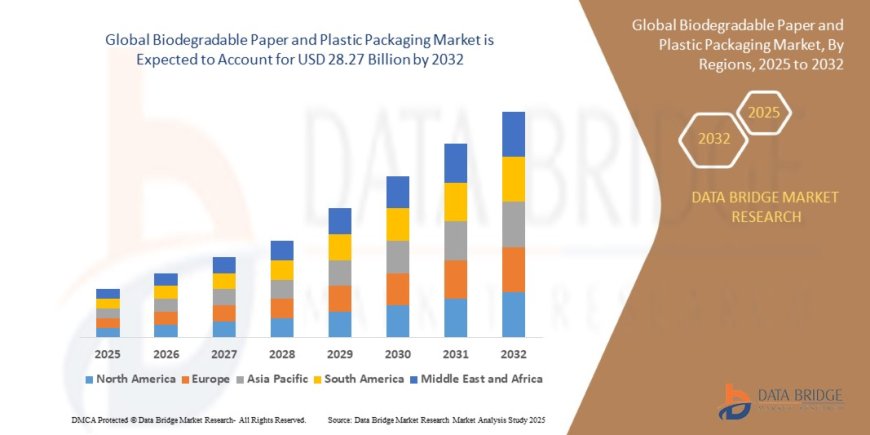Biodegradable Paper and Plastic Packaging Market: A Comprehensive Analysis
During the forecast period of 2025 to 2032 the market is likely to grow at a CAGR of 9.67%, primarily driven by increasing environmental concerns and government incentives

Introduction
The global shift towards sustainability has propelled the biodegradable paper and plastic packaging market into the spotlight. As environmental concerns mount and regulatory frameworks tighten, industries are increasingly adopting eco-friendly packaging solutions. This comprehensive analysis delves into the evolution, current trends, challenges, market scope, size, and growth drivers of the biodegradable packaging sector.
The Evolution
The packaging industry has undergone significant transformations over the decades. Initially dominated by materials like glass and metal, the mid-20th century saw a surge in plastic usage due to its versatility and cost-effectiveness. However, the environmental ramifications of plastic waste have led to a reevaluation of packaging materials.
Biodegradable packaging emerged as a response to the plastic pollution crisis. Early iterations included paper-based materials, but advancements have introduced bioplastics derived from renewable sources like cornstarch, sugarcane, and seaweed. Innovations such as Polymateria's biotransformation technology have further enhanced the biodegradability of plastics, ensuring they break down without leaving harmful residues.
Market Trends
Several key trends are shaping the biodegradable packaging landscape:
-
Regulatory Initiatives: Governments worldwide are implementing policies to reduce plastic waste. The European Union's Single-Use Plastics Directive and France's Anti-Waste and Circular Economy Law exemplify efforts to curtail single-use plastics and promote sustainable alternatives.
-
Consumer Demand: Increasing environmental awareness among consumers is driving demand for sustainable packaging. Brands are responding by adopting biodegradable materials to align with consumer values.
-
Technological Advancements: Innovations in materials science have led to the development of packaging solutions that are not only biodegradable but also functional and aesthetically pleasing. For instance, smart packaging technologies are being integrated to monitor product freshness and reduce food waste.
-
Corporate Responsibility: Companies are recognizing the importance of sustainability in their operations. Initiatives like Footprint's fiber-based packaging solutions highlight the industry's commitment to reducing environmental impact.
Challenges
Despite the positive momentum, the biodegradable packaging sector faces several challenges:
-
Infrastructure Limitations: Effective biodegradation often requires specific conditions found in industrial composting facilities. The lack of widespread composting infrastructure hampers the efficacy of biodegradable packaging.
-
Cost Implications: Biodegradable materials can be more expensive than traditional plastics, posing financial challenges for businesses, especially small and medium enterprises.
-
Performance Concerns: Some biodegradable materials may not match the durability and barrier properties of conventional plastics, limiting their applicability in certain sectors.
-
Consumer Confusion: Mislabeling and lack of standardized certifications can lead to consumer skepticism and improper disposal practices, undermining the benefits of biodegradable packaging.
Market Scope
The biodegradable packaging market encompasses a diverse range of materials and applications:
-
Materials: Includes biodegradable plastics (PLA, PHA), paper, cardboard, and edible films derived from seaweed and other natural sources.
-
Applications: Spans across food and beverage packaging, personal care products, pharmaceuticals, and agriculture.
-
Geographical Reach: While developed regions like Europe and North America lead in adoption, emerging markets in Asia-Pacific and Latin America are witnessing rapid growth due to increasing environmental awareness and regulatory support.
Market Size
As of 2025, the global biodegradable packaging market is experiencing robust growth. Factors contributing to this expansion include:
-
Regulatory Support: Policies promoting sustainable packaging are encouraging businesses to transition to biodegradable options.
-
Consumer Preferences: A growing segment of consumers is willing to pay a premium for eco-friendly products, driving market demand.
-
Corporate Initiatives: Companies are investing in research and development to create innovative biodegradable packaging solutions, further propelling market growth.
Factors Driving Growth
Several factors are fueling the growth of the biodegradable packaging market:
-
Environmental Concerns: Rising awareness about the detrimental effects of plastic pollution is prompting a shift towards sustainable packaging alternatives.
-
Legislative Measures: Government regulations banning or limiting single-use plastics are compelling industries to adopt biodegradable packaging.
-
Technological Innovations: Advances in materials science are enabling the development of biodegradable packaging that meets performance standards.
-
Corporate Sustainability Goals: Businesses are integrating sustainability into their core strategies, leading to increased adoption of biodegradable packaging solutions.
-
Consumer Behavior: A shift in consumer preferences towards environmentally responsible products is influencing market dynamics.
Conclusion
The biodegradable paper and plastic packaging market is poised for significant growth, driven by environmental imperatives, regulatory frameworks, technological advancements, and evolving consumer preferences. While challenges persist, ongoing innovations and collaborative efforts among stakeholders are paving the way for a more sustainable packaging future. As the industry continues to evolve, embracing biodegradable solutions will be crucial in addressing the global plastic pollution crisis and fostering a circular economy.
Other Trending Reports
https://www.databridgemarketresearch.com/reports/global-gin-market
https://www.databridgemarketresearch.com/reports/global-oud-extracts-market
https://www.databridgemarketresearch.com/reports/global-advanced-wound-care-market
https://www.databridgemarketresearch.com/reports/global-lentiviral-vector-market
https://www.databridgemarketresearch.com/reports/global-dandruff-treatment-market
https://www.databridgemarketresearch.com/reports/global-yoga-bar-market
https://www.databridgemarketresearch.com/reports/global-non-alcoholic-beers-market
https://www.databridgemarketresearch.com/reports/global-compound-feed-market
https://www.databridgemarketresearch.com/reports/global-strapping-equipment-market
https://www.databridgemarketresearch.com/reports/global-patau-syndrome-market





























































































































































